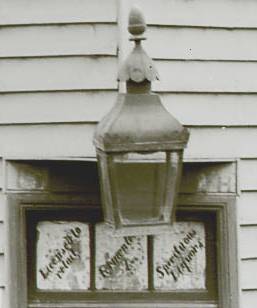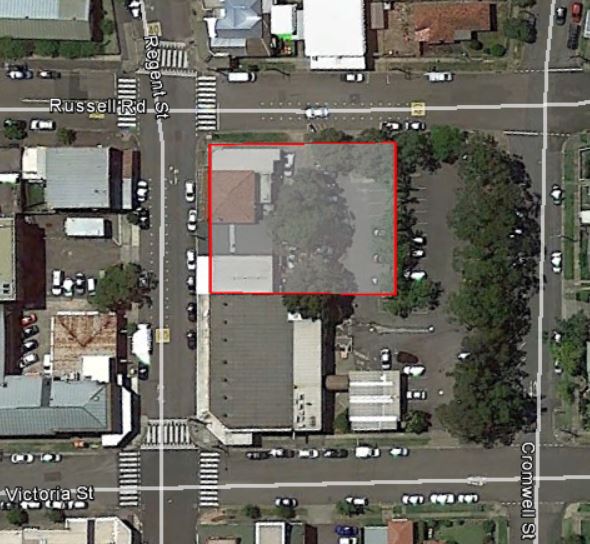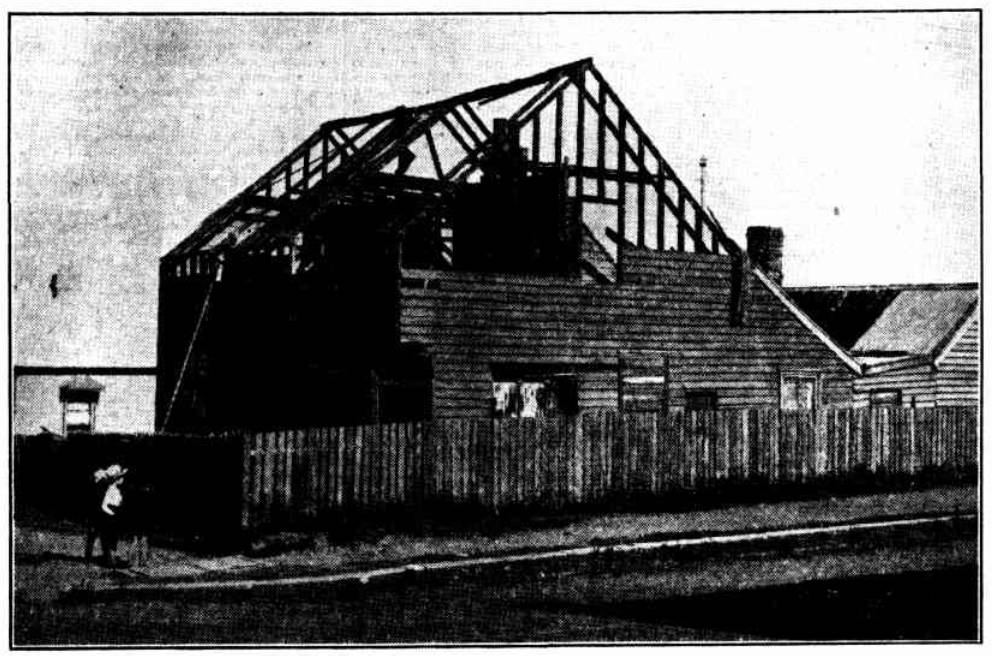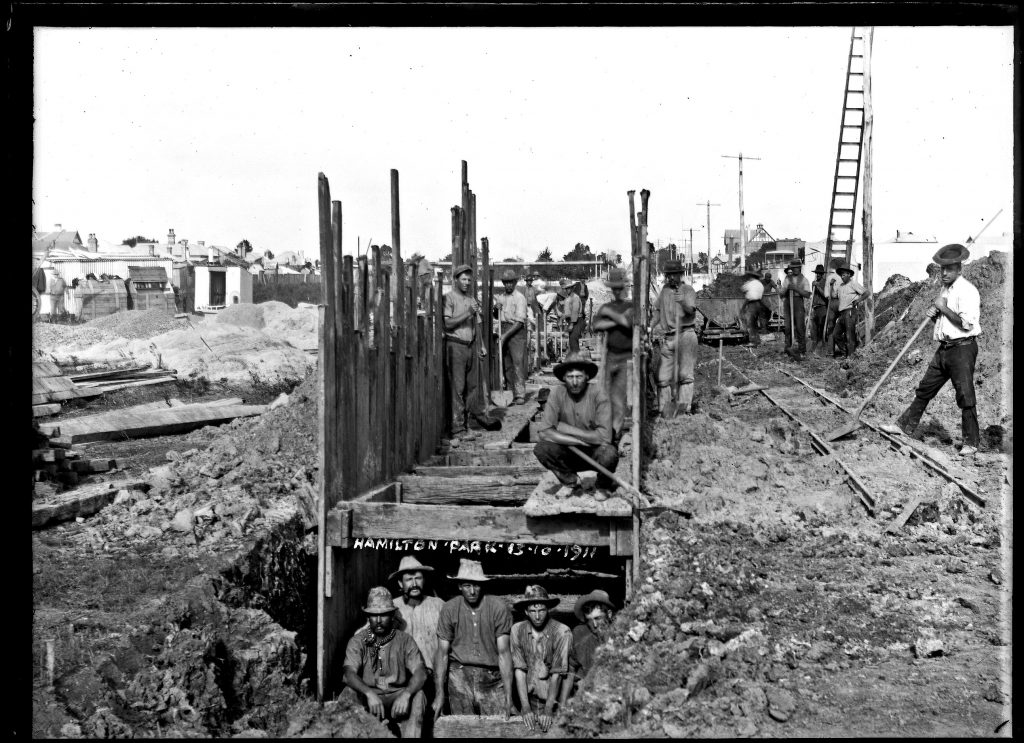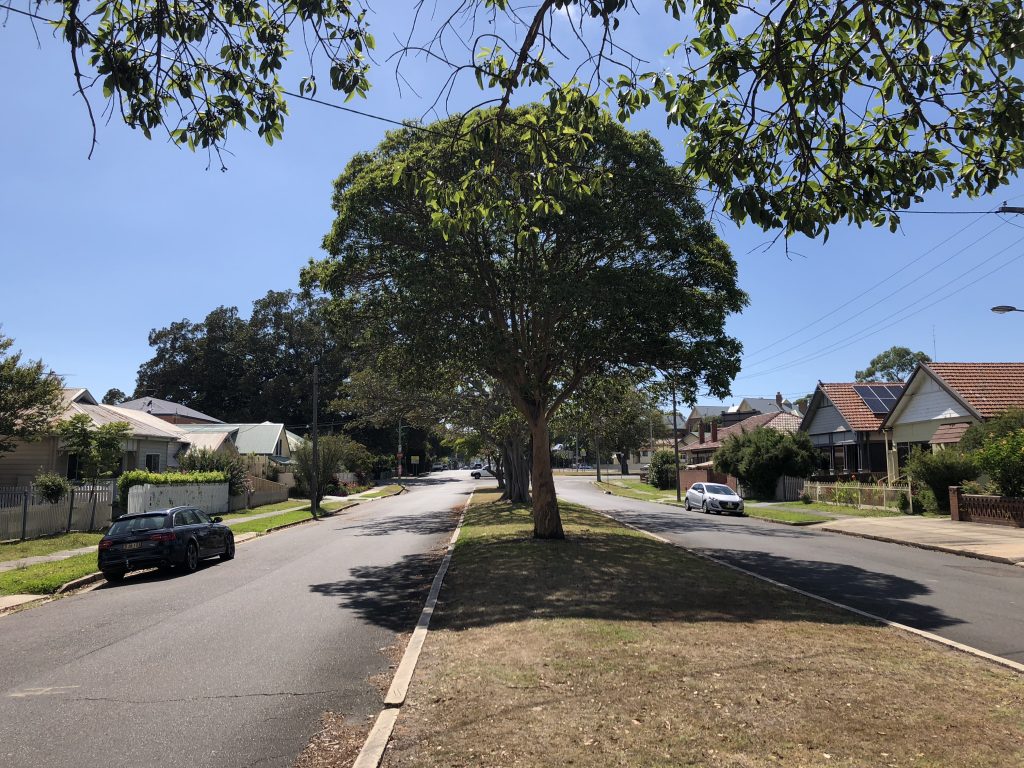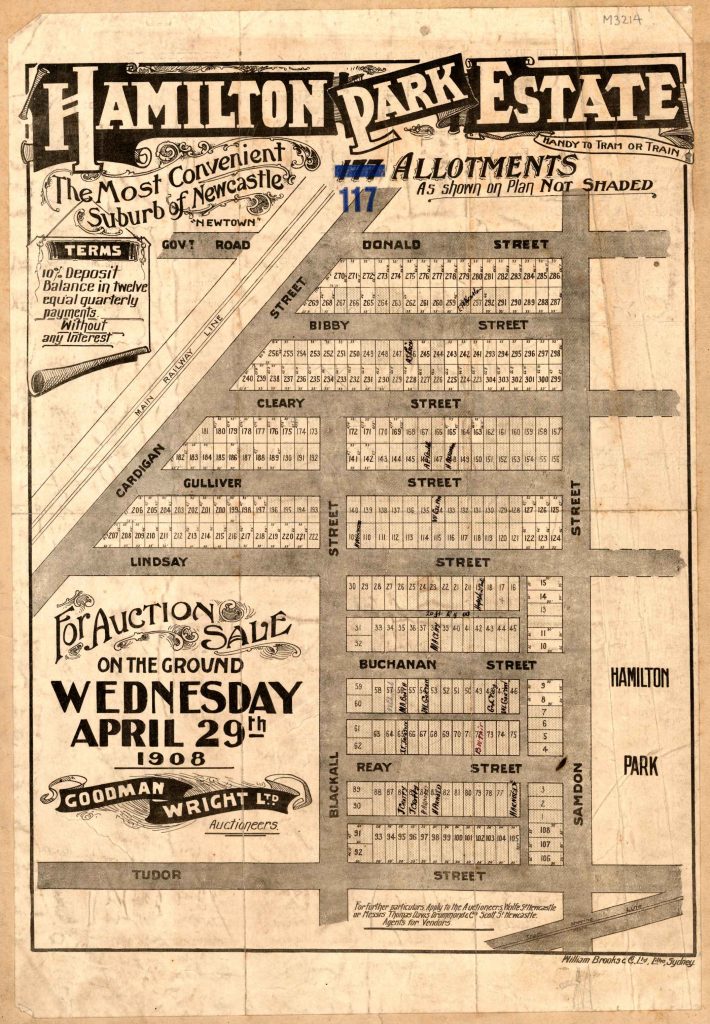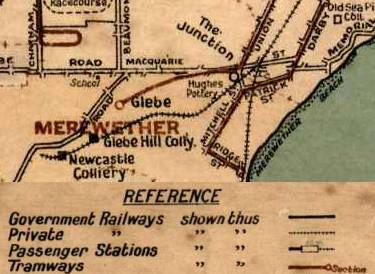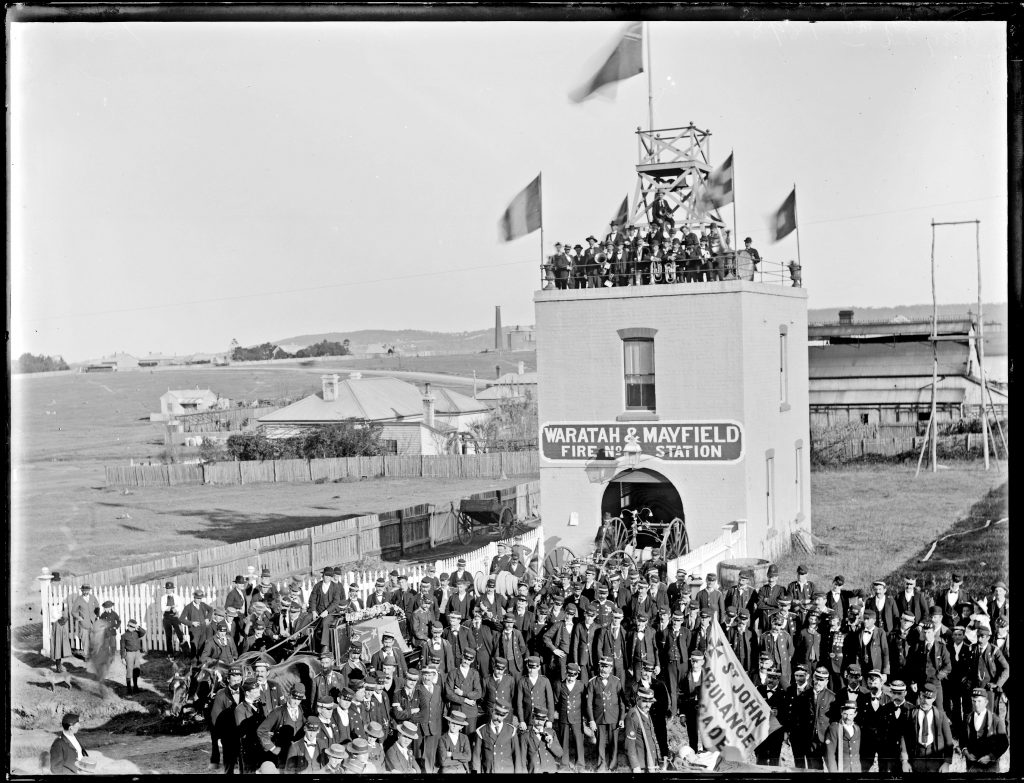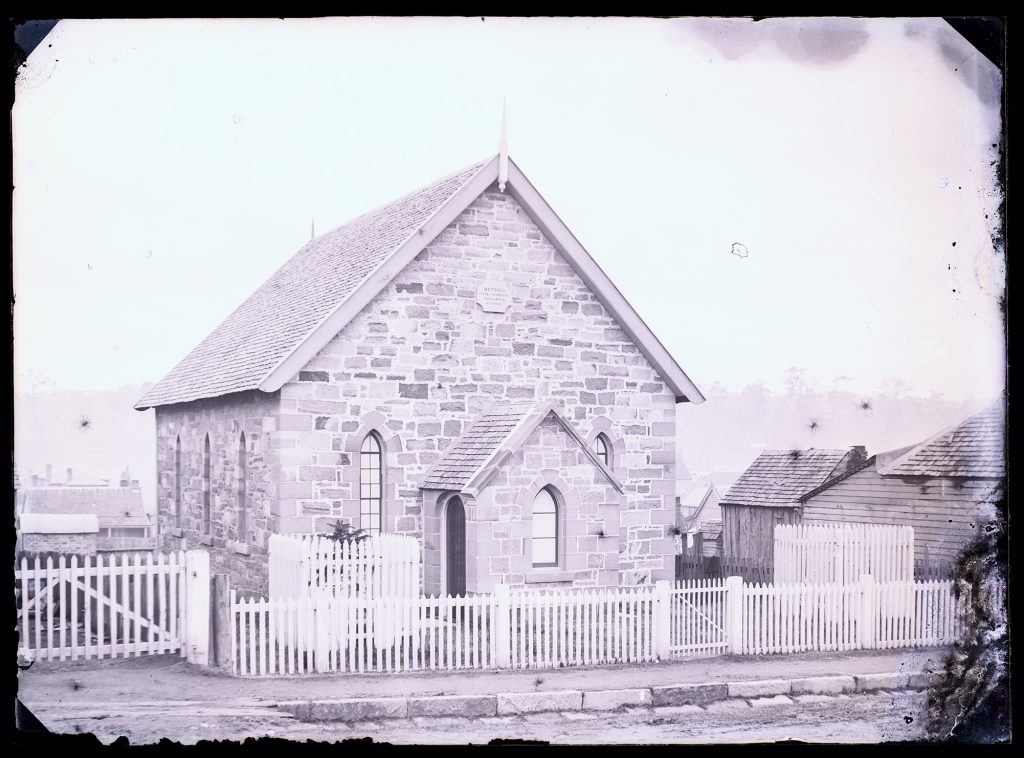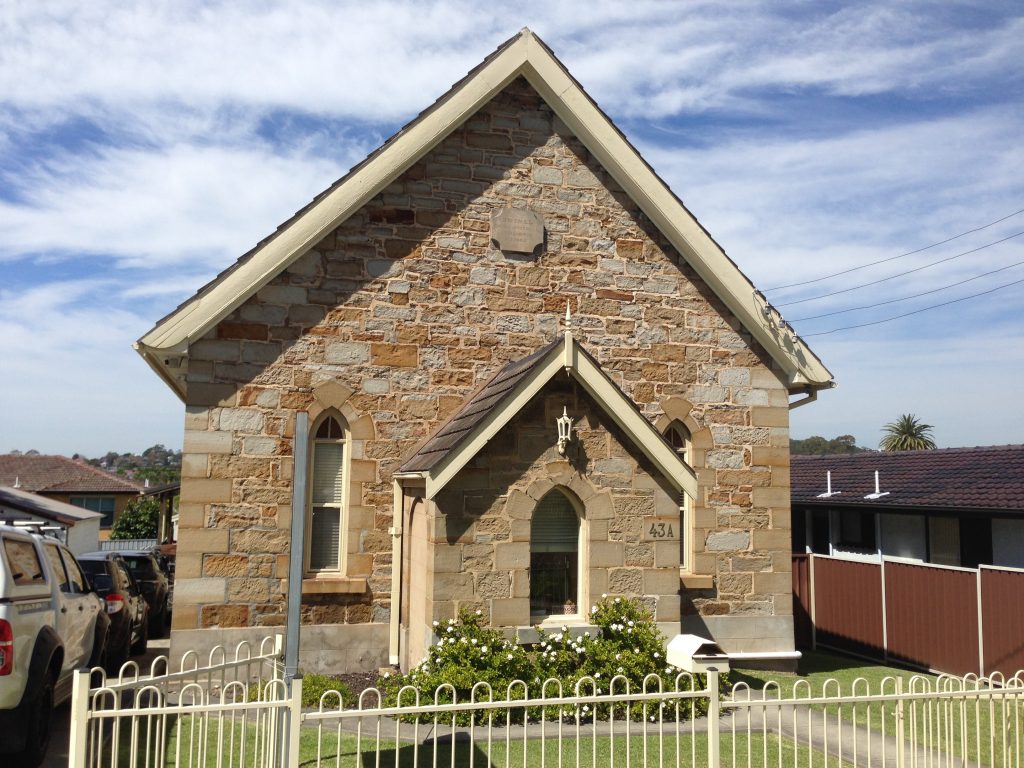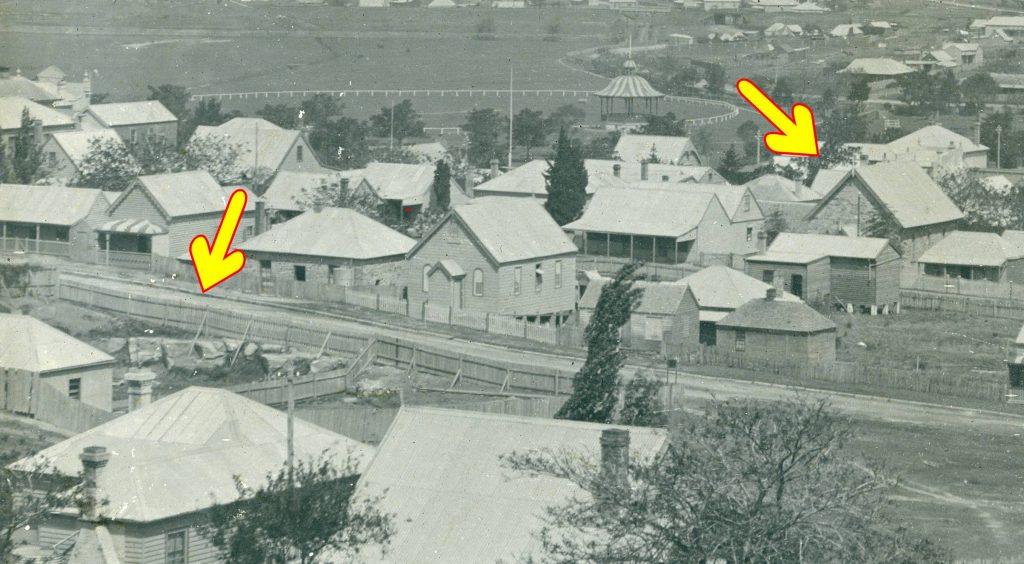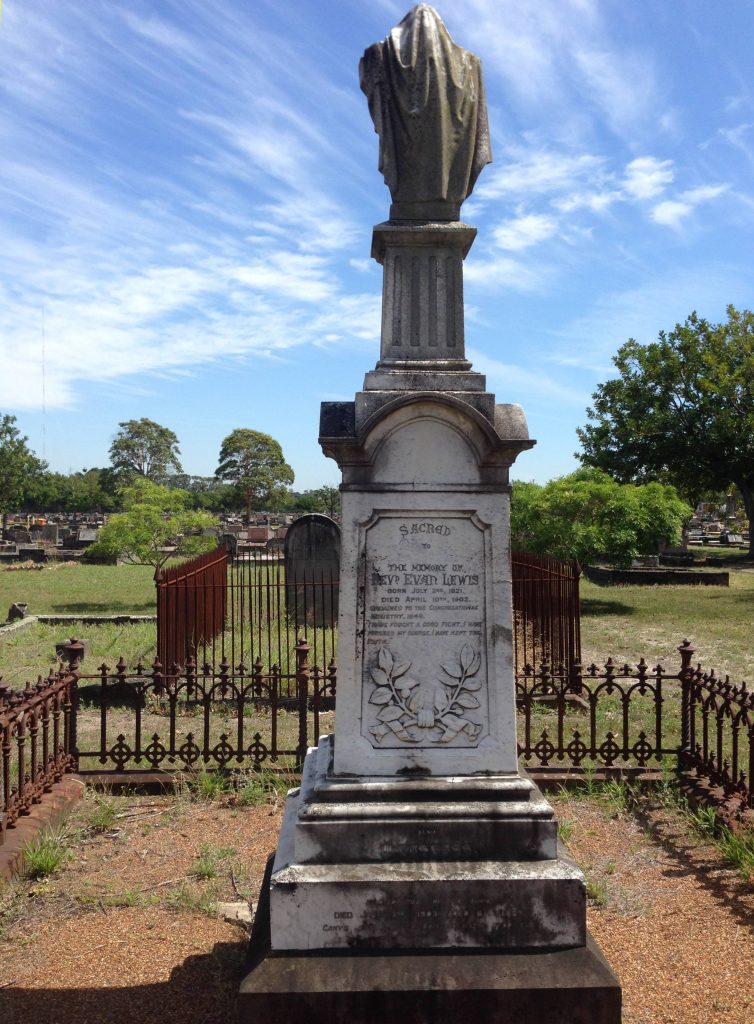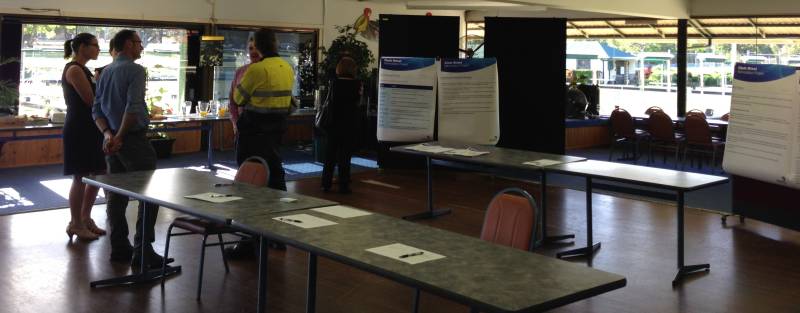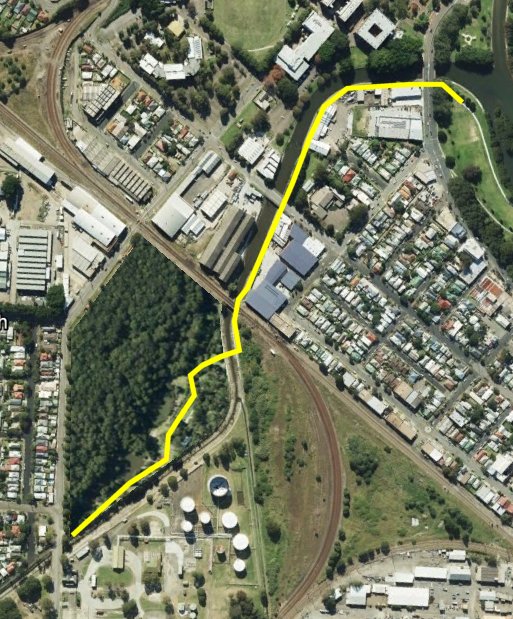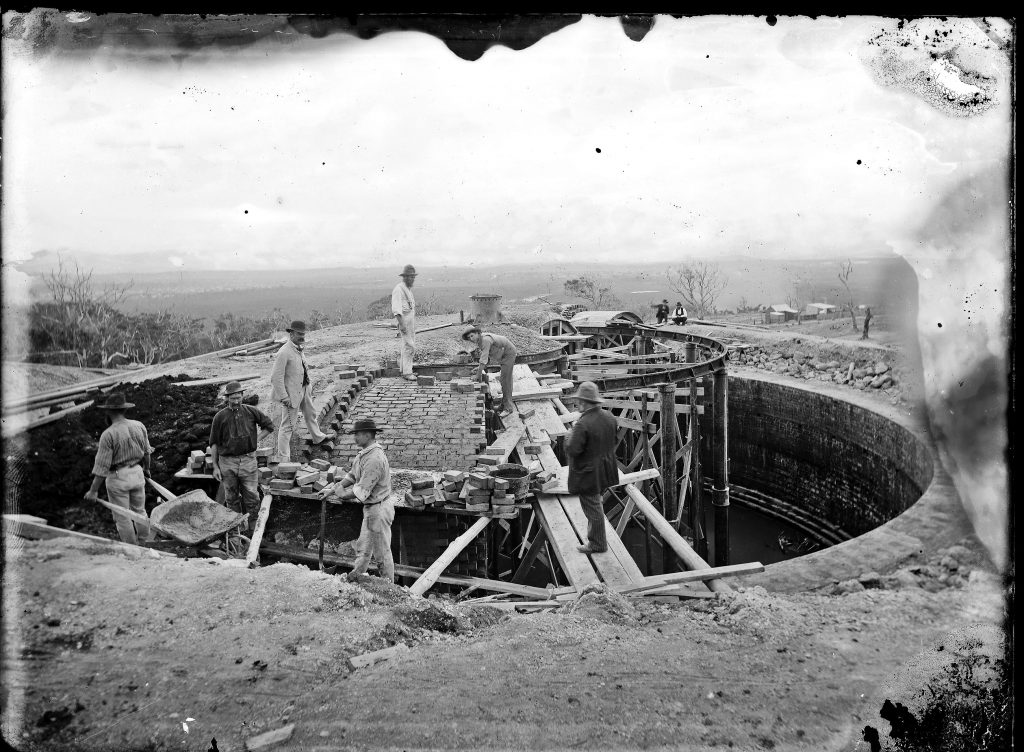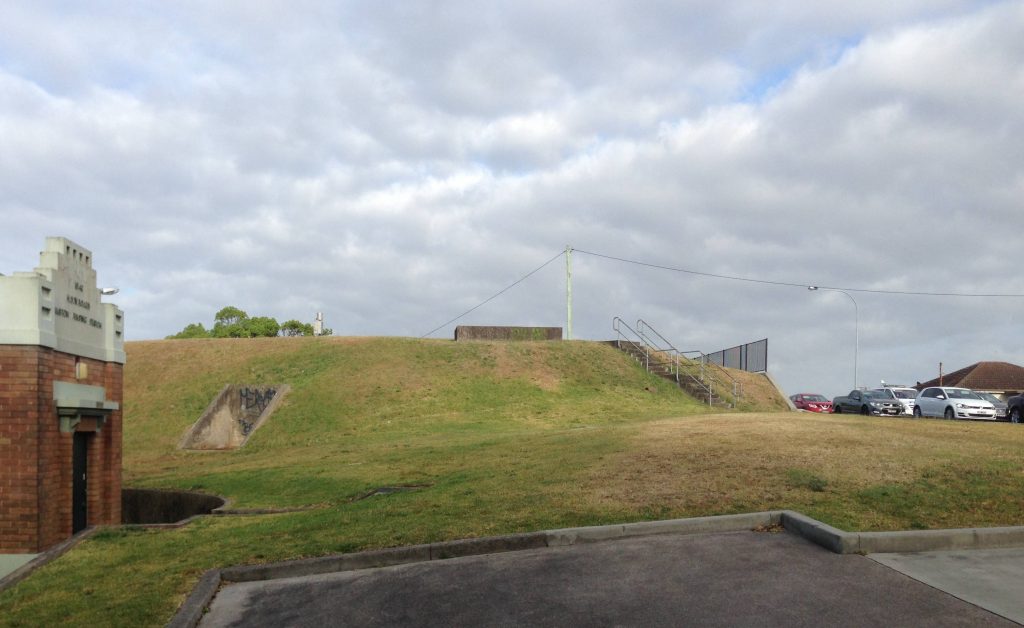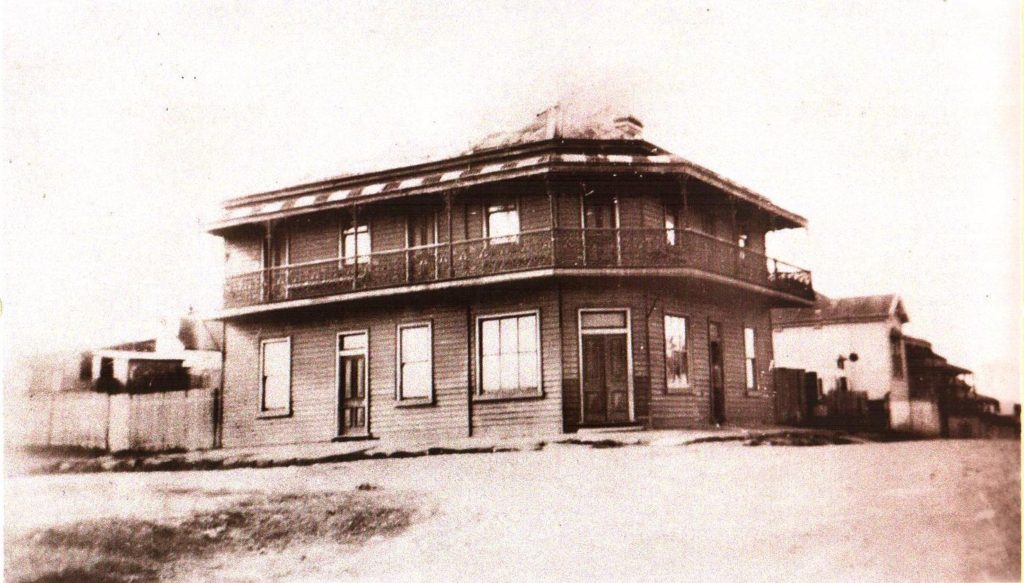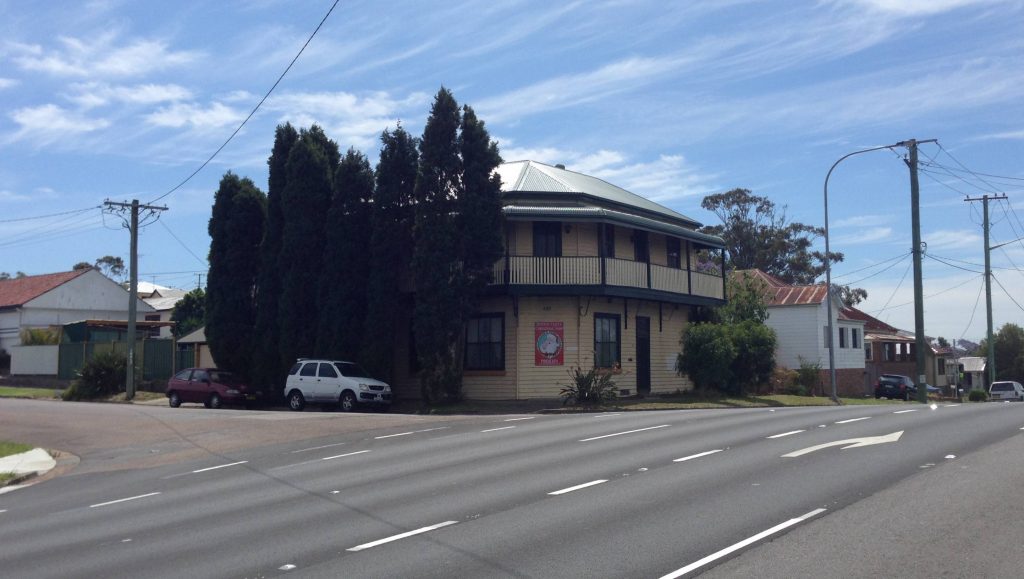And so will disappear an ancient landmark, which unfortunately will soon be forgotten.
These closing words of a 1933 newspaper report on a building demolition proved true, for few people today passing the corner of Regent St and Russell Rd know that it was the site of one of New Lambton’s earliest hotels.
The Hand of Friendship Hotel was opened on 18 September 1869, its first publican Benjamin Lunn pledging in an advertisement the sale of ‘none but the very best wines, spirits, ales etc.’ The premises also offered ‘abundant accommodation for the requirements of a colliery township.’ It was just the second hotel to open in New Lambton, when the town was barely a year old and the streets not yet formed.
Benjamin Lunn remained the publican until his death in 1878 when the hotel passed to his wife Jane, and later to their son James in 1884. In the ensuing years, the hotel had numerous licensees. Ralph Snowball photographed the hotel in September 1895, and the group standing at the door is almost certainly the publican of the day, George Masters, with his wife and two daughters.
In the next decade, the hotel passed through numerous hands and the building gradually deteriorated. In 1905, the police opposed the renewal of the hotel’s licence ‘on the ground that the building was in bad condition, owing to the white ants.’ It survived that objection, but only for another year. Plans to demolish the building and erect a new hotel came to nothing, and in 1906 John Canning, the last publican to stand behind the bar of the Hand of Friendship Hotel, relinquished his licence.
The building stood idle for some time before it was sold, when it gained a new life as a second-hand goods shop. The weathering of the years however was relentless. In 1933 the building was finally demolished, and a tangible link with New Lambton’s infancy was lost.
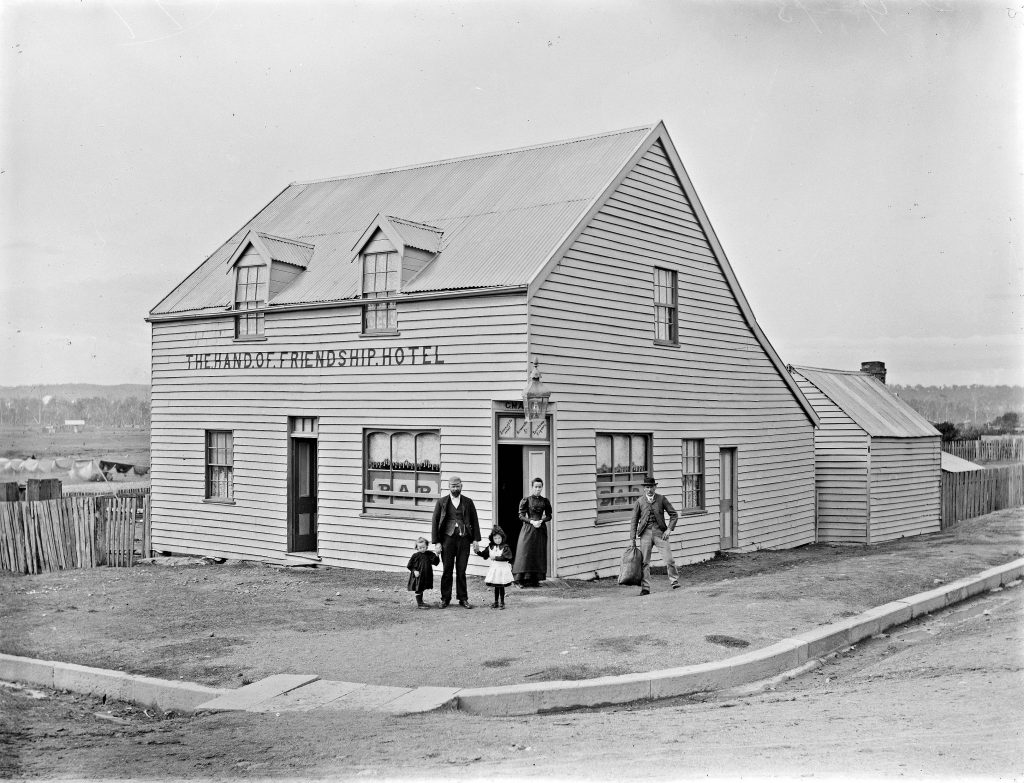
The article above was first published in the February 2018 edition of the Lambton & New Lambton Local.
Additional information
Opening

Snowball photographs
September 1895
In the September 1895 photo the name of the publican “G. Masters” can be partially seen in a sign above the door, behind the lamp.
The diagonal writing in the three panels below the name says:
Licensed to retail
Fermented l(iquors).
Spirituous liquors
In November 1894, ten months prior to the Snowball photo, a stable in the course of erection at the hotel collapsed in a strong wind. Three children were injured, including the six year old daughter of the publican, George Masters, who had her leg badly fractured below the knee. It is probable that the little girl on the right in the photo is the child who was injured in the accident.
May 1903
Eight years later, in May 1903 Ralph Snowball took another photograph of the hotel.
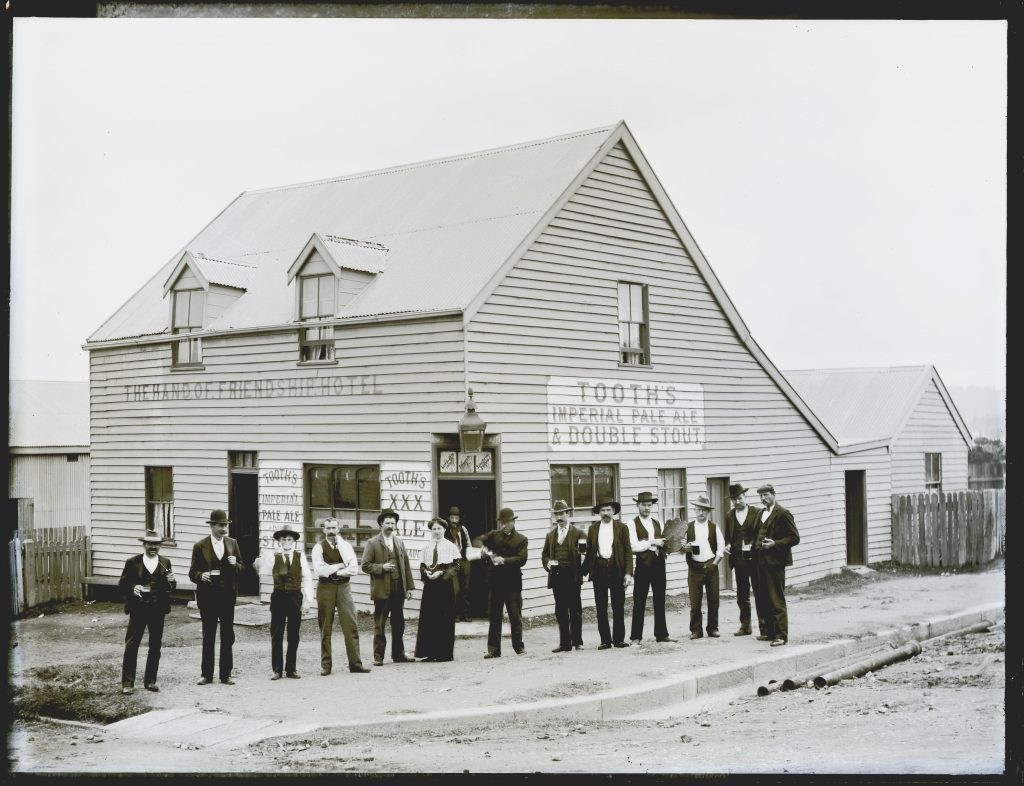
The publican at this time was Phillip James Byrne, having acquired the license from Edmund Butterworth three months earlier in February 1903. Note in the sign above the door there is a faint H at the end, which is probably the remnants of the name of the previous licensee.
In June 1903, just a month after this photograph was taken, the application of Phillip James Byrne for a renewal of the license was objected to on on the grounds that “the accommodation was inadequate, and the place in an insanitary condition.”
Centenary Hall
In 1906 the hotel ceased to trade, and in January 1907, the owners of the building, Tooth and Co., put the property up for sale. The sale included the land, hotel building, and the Centenary Hall adjacent to the hotel and fronting Russell Rd. The land was described as having frontage of 133ft 4in to Russell St, and 98ft 3in to Regent St.
The Centenary Hall was purchased by the New Lambton Mechanics’ Institute in 1908, and then dismantled and re-erected on the institute’s block on the corner of Regent St and Alma Lane in 1909.
Demolition
The 1933 report on the demolition of the building had an accompanying photograph. (The paper printed the photograph back to front as a mirror image. I have corrected the image below.)
Hotel licensees
The following is a list of licensees as gleaned from various mentions in newspaper articles over the years. Some of the dates are known with certainty, as there is a report of the license being transferred from one person to another. For some licensees I have had to make an informed estimate based on the first and last reported association of the licensee with the hotel.
- Benjamin Lunn (15 September 1869 to November 1878)
- Jane Lunn (November 1878 to March 1884)
- James Lunn (May 1884 to 1886)
- John Williams (1887 to 1888)
- John (Jack) Hall (June 1888)
- Thomas (Tom) Durham (June 1888 to November 1889)
- John (Jack) Thomas (November 1889 to 1892)
- George Masters (1893 to 1895)
- Joseph (Joe) Garratt (1896 to 1899)
- Edmund (Ted) Butterworth (1900 to Feb 1903)
- Phillip James Byrne (Feb 1903 to 1904)
- John (Jack) Canning (1904 to October 1906)
- George Bertram Bowser (October 1906 to November 1906)
The 1933 article on the demolition of the building states that “Ben Bradley (afterwards an alderman in the New Lambton Council)” was also a licensee, but I can find no independent evidence for this. Benjamin Bradley did have a publican’s license at one stage, but it was for the Lake Macquarie Hotel in Teralba.
The article also states that Jack Canning “was the last to stand behind the bar of the old hotel”. Although this is true, he wasn’t the last licensee. George Bertram Bowser was the final licensee, for just under a month in October/November 1906. The report on the cancellation of his licence in November 1906 however, makes it clear that the building remained unoccupied during his short tenure as publican.
Newspaper articles
| Article Date Event Date | Notes |
|---|---|
| 16 Sep 1869 15 Sep 1869 | A publican's license granted to Mr. Benjamin Lunn, of the Hand of Friendship, New Lambton. |
| 16 Sep 1869 | A general article describing the beginnings of New Lambton, that notes that the Hand of Friendship Hotel is the second hotel in the township. "Both these houses afford abundant accommodation for the requirements of a colliery township." |
| 18 Sep 1869 18 Sep 1869 | Advertisement for the opening of the Hand of Friendship Hotel, New Lambton. |
| 29 Nov 1878 27 Nov 1878 | Death of Mr. Benjamin Lunn, landlord of the Hand of Friendship Hotel, New Lambton. |
| 5 Apr 1884 28 Mar 1884 | Death of Jane Lunn, Hand of Friendship Hotel. |
| 24 May 1884 21 May 1884 | "The license of the Hand of Friendship Hotel, New Lambton, was transferred from the executors in the estate of the late Mrs. Jane Lunn to James Lunn." |
| 17 Dec 1886 | Reference in a court hearing to "James Lunn, hotelkeeper, at New Lambton". Although the hotel is not named, it is presumed that it the Hand of Friendship hotel. |
| 23 Mar 1887 | "An inquest was held at New Lambton yesterday, at Mr. John William's Hand of Friendship Hotel." |
| 14 Mar 1888 | At a court hearing where he was a witness, John Williams is described as the "late licensee of the Hand of Friendship Hotel, New Lambton." |
| 30 May 1888 | "FOR SALE, the Lease, License, and Good will of the HAND OF FRIENDSHIP HOTEL, New Lambton, now doing a good business." |
| 7 Jun 1888 | "An application was put in for the transfer of the license of the Hand of Friendship Hotel, New Lambton, from John Hall to Thomas Durham.--Granted." |
| 8 Jun 1889 | "FOR SALE, Lease, License, Furniture, and Goodwill of the HAND OF FRIENDSHIP HOTEL, New Lambton. Apply to THOMAS DURHAM, on the premises." |
| 14 Nov 1889 | "The license of the Hand of Friendship Hotel, New Lambton, was transferred from Thomas Durham to John Thomas" |
| 24 Jun 1892 | License renewal to "John Thomas, Hand of Friendship, New Lambton". |
| 25 Mar 1893 | Charge of Sunday trading against "George Masters, of the Hand of Friendship Hotel, New Lambton" was withdrawn. |
| 13 Nov 1894 12 Nov 1894 | The roof of a stable in the course of erection at the Hand of Friendship Hotel is blown off by a strong gust of wind. The building then collapsed and three children are injured, including the six year old daughter of the publican, George Masters, who had her leg badly fractured below the knee. |
| 26 Jun 1896 | Renewal of license to "Joseph Garrett, Hand of Friendship, New Lambton". |
| 27 Mar 1899 | At a performance by the Fire Brigades' Band, "ample seating accommodation" was provided by "Mr. Joseph Garratt, of the Hand of Friendship Hotel." |
| 21 Jul 1900 | Advertisement. "FREE Public Dance, Monday Night, Butterworth's Centenary. Hall, New Lambton. Noble and Gaggetta, Musicians." The Centenary Hall was part of the Hand of Friendship Hotel site. |
| 21 Aug 1902 | "Mr. G. C. Martin, district coroner, held a magisterial inquiry at Butterworth's Hand of Friendship Hotel, New Lambton, yesterday morning." |
| 14 Feb 1903 | "Mr. Scott, S.M., granted a transfer of the license of the Hand of Friendship Hotel, New Lambton, from E. Butterworth to P. J. Byrne." |
| 19 Jun 1903 | "The application of Phillip James Byrne for a renewal of the license of the Hand of Friendship Hotel, New Lambton, was objected to on a report, furnished by Sergeant G. Salter, to the effect that the accommodation was inadequate, and the place in an insanitary condition." |
| 18 Nov 1903 | For Sale: "HOTEL, New Lambton, Tooth's Beer, long lease, good trade, low rent, cheap. Byrne, Hand of Friendship." |
| 16 Sep 1904 | Bazaar in aid of New Lambton Mechanics' Institute to be held in "Canning's Centenary Hall." |
| 23 Jun 1905 | "John Canning, Hand of Friendship Hotel, New Lambton, applied for renewal of license. The police opposed the application on the ground that the building was in a bad condition, owing to the white ants. Mr. T. A. Braye (Messrs. Braye and Cohen) appeared for the applicant and said that plans had been prepared for a new building, which would be erected. Temporary improvements would also be made. Michael Joseph Moroney, representing the owners, Tooth and Co., confirmed this statement, and the renewal was granted." |
| 19 Jun 1906 | Plans to build a new hotel on the site of the Hand of Friendship Hotel … "the firm of Tooth and Co. contemplate erecting a large hotel on the present site of their hotel property, situated at the corner of Regent-street and Russell-road." |
| 12 Oct 1906 | LICENSING COURT. The following transfers were approved :- From John Canning to George Bertram Bowser, Hand of Friendship Hotel, New Lambton, and from Thomas Mclntosh to John Canning, Sportsman's Arms, New Lambton. |
| 9 Nov 1906 | "In the matter of the Hand of Friendship Hotel, New Lambton, Sub-Inspector Goulder applied for cancellation of the license. The hotel changed hands on October 11, and since that date had remained unoccupied. The license, which was held by W. Bowser, was formally cancelled." |
| 23 Jan 1907 | For sale - "THAT PROPERTY KNOWN AS THE Hand of Friendship Hotel, Fronting Regent-street, and THE CENTENARY HALL, Fronting Russell-street." |
| 2 Nov 1933 | Report on the demolition of the Hand of Friendship Hotel building. |



